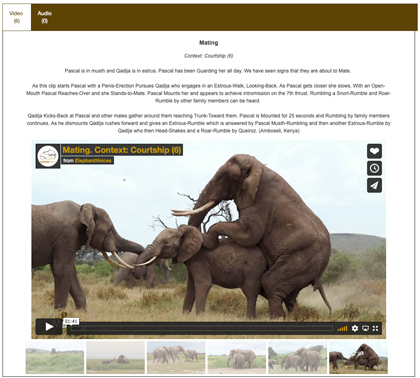The Elephant Ethogram is a uniquely detailed catalogue, or library, of the behavior and communication of African savanna elephants (Loxodonta africana). It is based on decades of ElephantVoices behavioral studies, photographs, and audio and video recordings, the referenced research of other elephant biologists, as well as professional and amateur footage made available to ElephantVoices. You can read more about how elephants communicate within this section of elephantvoices.org. The Elephant Ethogram was launched in May 2021.
 The Elephant Ethogram consists of written and referenced descriptions, video examples, photographic illustrations and, where relevant, audio recordings, of 322 Behaviors, 103 Behavioral Constellations and 23 Behavioral Contexts. There are close to 3,000 media files in the fully searchable Elephant Ethogram including 2,408 video clips (18 August 2021).
The Elephant Ethogram consists of written and referenced descriptions, video examples, photographic illustrations and, where relevant, audio recordings, of 322 Behaviors, 103 Behavioral Constellations and 23 Behavioral Contexts. There are close to 3,000 media files in the fully searchable Elephant Ethogram including 2,408 video clips (18 August 2021).
The concept and structural design of The Elephant Ethogram was developed by Joyce Poole and Petter Granli of ElephantVoices. Programming and database maintenance is handled by Derrick Joel, Nairobi, Kenya in collaboration with Petter. The Elephant Ethogram is coded in open source software PhP and MySQL in Joomla! CMS, and is hosted on Cisco servers as a section of elephantvoices.org. Video and audio is hosted on Vimeo and SoundCloud, respectively.
What is an Ethogram?
An ethogram is a comprehensive list, inventory, catalogue or description of the behaviors or actions exhibited by a species. It is a library, or master list, of all known behaviors for a species that describes the characteristics and, where possible, the function of each behavior. The word ethogram comes from the words “etho,” meaning the characteristic and distinguishing attitudes, habits, beliefs, etc. of an individual or group, and “gram,” meaning to write down or record.
Why an Elephant Ethogram?
African savanna elephants are among the most socially complex non-human species on our planet, but their lives and behavior are increasingly impacted by humans. The Elephant Ethogram aims to document the rich behavior and communication of this species, including rare, novel and idiosyncratic behavior, and those acquired, through social learning, in response to rapidly increasing anthropogenic threats. We intend The Elephant Ethogram to be a repository for scientific study and comparison, and to inspire broader interest in elephant behavior, conservation and welfare.
The Elephant Ethogram - basics
A Behavior is a unique movement or action in response to a particular situation or stimulus, while a Constellation is a suite of Behaviors that typically occur together. A Context refers to the circumstances or setting in which a behavior takes place.
 All Behaviors and Constellations are documented with written and referenced descriptions, and one or more video examples. Vocalizations may be documented by audio recordings, instead of, or in addition to, video.
All Behaviors and Constellations are documented with written and referenced descriptions, and one or more video examples. Vocalizations may be documented by audio recordings, instead of, or in addition to, video.
Each video and audio file includes a detailed annotation describing the context, individuals present, signaler(s) and recipient(s), and their respective actions and behavior. Each video is labeled with the Behavior/Constellation it is intended to illustrate. To focus your attention on the correct individual, body part, or action, a circle may appear at the start of the particular behavior illustrated and, in many cases, will remain for the duration of the action. In cases where the change in behavior is very subtle, such as Listening, closed circles may appear next to the label as the behavior begins and remain until the behavior ends.
Videos that illustrate vocalizations include a sound icon after the label. In some cases the icon appears only as the elephant vocalizes, otherwise the vocalizing elephants are circled, unless the caller is obvious.
Navigating The Elephant Ethogram
You can access The Elephant Ethogram in several ways. The Search Portal offers multiple search options to Behaviors and Constellations and a slideshow with illustrative, images of selected Behaviors each linked to a description and further documentation. The Ethogram Table contains definitions of the Contexts and provides links to the Behaviors and Constellations that occur in each. For a detailed description of how to use The Elephant Ethogram please read the User Guide.
The Science Section
The Science section offers more detail about The Elephant Ethogram for scientists and those who are interested in learning more about how the work was accomplished. It includes an Abstract, Introduction, Methods, a basic set of Results and Discussion of them, and References. The Elephant Ethogram is a work in progress. Once TEE has been fully populated we will expand the Results and Discussion section with conclusions drawn from the data. A scientific publication about The Elephant Ethogram was published in Pachyderm 30 October 2021.
Selected media coverage The Elephant Ethogram (Launched in late May 2021)NewScientist, 3 November 2021 Do you speak elephant? With this new dictionary you will.https://www.newscientist.com/article/mg25233590-900-do-you-speak-elephant-with-this-new-dictionary-you-will Scientific American, 9 June 2021 The First ‘Google Translate’ for Elephants Debuts. An online animal catalogue lets you decode communications and other behaviors for everyone’s favorite pachyderm.https://www.scientificamerican.com/article/the-first-google-translate-for-elephants-debuts/ New York Times, 4 and 8 June 2021 What Has Four Legs, a Trunk and a Behavioral Database? From tens of thousands of hours of observation, scientists have compiled a detailed library of African elephant behavior.https://www.nytimes.com/2021/06/04/science/african-elephants-ethogram-behavior-poole.html The article was published in New Your Times' print edition on Tuesday 8 June 2021. Click on link below to download (3.2 mb). NPR, 30 May 2021 Scientist Joyce Poole On What Elephants Have To Sayhttps://www.npr.org/2021/05/30/1001684767/scientist-joyce-poole-on-what-elephants-have-to-say FURTHER AFRICA, 28 May 2021 Gorongosa National Park’s elephants featured in landmark new project about elephant behaviourhttps://furtherafrica.com/2021/05/28/gorongosa-national-parks-elephants-featured-in-landmark-new-project-about-elephant-behaviour/ SÜD-AFRIKA Magazin Neue Datenbank für die Elefantenforschunghttps://www.sued-afrika.de/artikel/mz-elefanten-gorongosa/ Forbes, 25 May 2021 Roar-Rumble And Squeal-Trumpet: Scientists Compile An Elephant Lexiconhttps://www.forbes.com/sites/andreamorris/2021/05/25/roar-rumble-and-squeal-trumpet-scientists-create-an-elephant-lexicon National Geographic, 25 May 2021 What are elephants really ‘saying?’ First-ever library reveals communication mysteries.https://www.nationalgeographic.com/animals/article/new-elephant-library-reveals-communication-mysteries |

